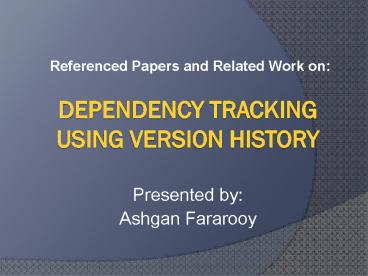Dependency Tracking Using Version History - PowerPoint PPT Presentation
Title:
Dependency Tracking Using Version History
Description:
Understanding source code evolution using abstract syntax tree matching ... three features of software development. work that are revealed by recomposition: ... – PowerPoint PPT presentation
Number of Views:21
Avg rating:3.0/5.0
Title: Dependency Tracking Using Version History
1
Dependency Tracking Using Version History
Referenced Papers and Related Work on
- Presented by
- Ashgan Fararooy
2
Possible Related Papers
- Automatic Inference of Structural Changes for
Matching Across Program Versions - An Approach to Software Evolution Based on
Semantic Change - Understanding source code evolution using
abstract syntax tree matching - Recomposition - Coordinating a Web of Software
Dependencies - Identifying the Semantic and Textual Differences
Between Two Versions of The Program - Visualizing and Querying Software Structures
3
Automatic Inference of Structural Changes for
Matching Across Program Versions
- Miryung Kim,
- David Notkin,
- Dan Grossman
4
Abstract
- Goal Mapping code elements in one version of a
program to corresponding code elements in another
version - A fundamental building block for many software
engineering tools - Tools that match code elements or identify
structural changes (refactorings and API
changes) - Version merging tools
- Regression testing tools
- Profile propagation tools
5
Abstract
- Two important limitations of such tools
- Having difficulty disambiguating among many
potential matches or refactoring candidates - Hard to analyze their outcome due to an
unstructured representation of results - Proposed approach to overcome these limitations
- Represent structural changes as a set of
high-level change rules - Automatically infer likely change rules and
determines method-level matches based on the rules
6
Motivation
- Interest in mining software repositories is
demanding more effective and systematic matching
techniques - The unstructured, usually lengthy, list of
matches or refactorings may prevent the result of
existing tools from being broadly used in mining
software repository research
7
Background
- To match code elements, the differences between
two programs must be identified - Computing semantic differences is undecidable
- Tools typically approximate matching via
syntactic similarity - Existing refactoring reconstruction tools look
for code changes that match a predefined set of
refactoring patterns - Problem either too many refactoring candidates
or no candidates
8
Change Rules
- Question Given two versions of a program, what
changes occurred with respect to a particular
vocabulary of changes? - A change vocabulary characterizes the
applications for which the matching results can
be used - For example, diff defines a change vocabulary
in terms of delete, add, and move line
9
Change Rules
- The paper introduces a change vocabulary with the
goal of representing groups of related
homogeneous changes precisely - The core of their change vocabulary is a change
rule consisting of a quantifier and a scope to
which a low-level transformation applies - For all x in (scope - exceptions),t(x), where t
is a transformation, scope is a set of code
elements, and exceptions is a subset of scope - Their change vocabulary describes structural
changes at or above the level of a method header
10
Change Rules
- Transformation Samples
11
Change Rules
- Change Rule Samples
- All methods whose class name either includes Plot
or JThermometer changed their package name from
chart to chart.plot
12
Change Rules
- Change Rule Samples
- All methods that match the chart.Plot.getRange()
pattern take an additional ValueAxis argument,
except the getVerticalRange method in the
MarkerPlot class
13
Rule-based Matching
- The paper defines a matching between two versions
of a program by a set of change rules - The scope of one rule may overlap with the scope
of another rule as some methods undergo more than
one transformation - The inference algorithm ensures that it infers a
set of rules such that the application order of
rules does not matter - The methods that are not matched by any rules are
deleted or added methods
14
Applications of Change Rules
- Bug Finding
- Assisted Documentation
- API Evolution Analysis
- API Update
- Identifying Related Changes
15
Evaluation Conclusion
- By applying their tool to several open source
projects, the authors show that it identifies
matches that are difficult to find using other
approaches - They also show their approach produces more
concise results than other approaches - They claim their approach is the first to
automatically infer structural changes and
represent them concisely as a set of rules
16
Recomposition Coordinating a Web of Software
Dependencies
- Rebecca E. Grinter
17
Abstract
- Revisiting the concept of "recomposition
- All the work that development organizations do
to make sure that their product fits together and
into a broader environment of other technologies - Technologies, such as Configuration Management
(CM) systems, can ameliorate some of a software
development teams need to engage in
recomposition - Technological solutions do not scale to address
other kinds of recomposition needs
18
Summary
- The paper focuses on various organizational
responses to the need for recomposition - Describes how those responses are manifested in
the day-to-day communications and
responsibilities of individuals throughout the
organization - Highlights how changes in an organization
complicate recomposition
19
Conclusion
- The paper concludes with a discussion of
- three features of software development
- work that are revealed by recomposition
- The affects of environmental disturbances on
development work - The types of dependencies that require
recomposition - The images of organizations required to manage
the recomposition
20
Thank you































